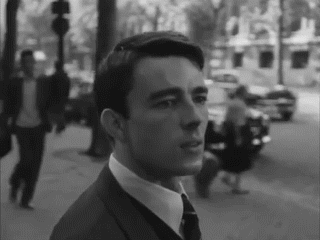
‘It comes as a surprise when the cinema of a quite well known actor like Gérard Blain (a darling of the Nouvelle Vague, acting in short films by Truffaut and Godard, in Chabrol‘s Le Beau Serge and Les Cousins, in Un homme de trop for Costa-Gavras and even Hatari! for Howard Hawks) from a country like France is almost invisible abroad. How those disappearances come into place is out of my understanding. Especially when one happens to find out that Blain‘s films easily rank among the more interesting works French cinema has produced. And that means a lot. But whose responsibility is it to discover? Today almost any viewer has the possibility to search for unknown cinema. But we also live in an age where there are too many things flying around disguised as cinema when in reality there is too little cinema.
‘But now, who is Blain? Of course, we cannot tell. But we could see his films. His cinema often deals with personal experiences and memories of childhood and past. The most obvious formal influence seems to be Robert Bresson but this leads to wrong expectations. Of course, Blain like Bresson is very interested in the concept of minimalism. He tries to show only what is absolutely necessary. A good example for this can be found in the stunning beginning of Le Pélican. We see the birth of a son, his father, the child sleeps, grows up, just images like a dream, the moments father and son spend together in a zoo, in a tram for children. In retrospective we recognize these moments as a memory of harmony. Blain who plays the father himself really loves in those scenes with his actual son(s). But the filmmaker never strips down his images like Bresson did. He is more interested in the personal aspects of cinema which makes him a perfect combination with Eustache and Pialat. He will always choose the emotion before the image, his perception before form. There are some strong and some weak points about this, in general it creates an individual point-of-view and this rare feeling of having a human being behind (and in the case of Blain also before) the camera. Nevertheless sometimes it seems strange that we encounter with Blain a quasi formalistic approach that is ready at any second to throw itself overboard in favor of a certain scene or an emotion that the filmmaker wants to stress. A good example for such a lack of consequence can be found at the end of Le rebelle when Blain cannot stop cutting to the crying face of the abandonned sister of the protagonist. Unlike Bresson tenderness is not a question between the images, it is an obvious answer in them. Due to that it is not really Bresson who Blain is in relation with, it is Truffaut. That might seem strange in the beginning but thinking about it I came to realize that both directors are not only concerned with visions from the past, a strong faith in humanity, insecurities, moments where cinema and memories merge, but they also are both obsessed with the beauty and cruelty of dependencies.
‘Blain‘s characters struggle for freedom but their way to achieve it always brings them into situations in which they depend on the lust and money of other people. In Les Amis it is 16-year old Paul who struggles and who meets Philippe, an elderly business man who offers him in unbearable ambivalences a friendship and a little bit more. Paul like his namesake in Un enfant dans la foule goes for it but soon he will fall in love with a girl. The opposite is true for an amazing Patrick Norbert in Le rebelle. He denies the much more obvious seduction of money and does not prostitute himself so easily. But this leads to other problems. It is clear that in relationships like that lies a metaphorical potential for many injustices of the world, including what Blain, who always thought of himself as an outsider, must have encountered when making cinema. But those patrons have always something vulnerable and honest about them which makes their egoism and desire even more dangerous. Especially since Blain shows both sides in his filmography: The seducer and the seduced. What is a violent abduction from one perspective might be desperate love from the other perspective. Age difference and deformed tenderness play a huge role in Blain‘s cinema. We often see people kiss or embrace and freezing in a Fassbinder-like pose. Suddenly movement stops and something seems wrong. It is too close, too long, too wanted. But the wrongness is not a question of a calculated crime, it is one of human weakness. In Un second souffle Blain turns around the dependency and focuses on an aging man (played by Robert Stack who grew up part of his life in Paris and spoke fluently French, therefore acted in several French films) and his fight to stay young. He takes himself a much younger girlfriend and Blain does not shy away from irritating our gaze as sometimes we take his lover for his possible daughter. The naturalness of this kind of relationship presented in Fin août, début septembre by Olivier Assayas gets an existentialist alienation with Blain. Among those who visited the screenings of Blain I seem to hold an exclusive opinion on this, but for me Un second souffle is the best of the five films. Part of this owes to the amazing camera work of Emmanuel Machuel (who worked with Bresson, Pialat and Mr. Costa among others). Machuel also photographed stunningly Un enfant dans la foule and Le rebelle but in Un second souffle the way he connects movement with expectation and finally disappointment is on top of his game. The film opens and closes with the character of Stack running through the streets, a park and a forest. The camera travels with him and pans as he moves towards or away from us. In the beginning we see someone who comes out of the forest, there is a time he takes, a way he looks, an insecurity, a hunger whereas the almost same images in the end carry death and discouragement but also acceptance. It is a huge quality of Machuel to keep the right distance, one that makes us feel the movement of the camera as something that takes power, tenderness and time as opposed to many of those camera movements nowadays which more or less fly through the air. The emotions of this camera movement mirror in the protagonist. Stack‘s attempts to become young again carry the kind of hypocritical embarrassment we know from a filmmaker like Pialat. But there is an honesty about it that keeps us and the films moving. In a vibrantly delivered scene Stack talks to his younger girlfriend about another boy her age she knows. They lie in bed together, it is something uncomfortable but nobody would want to leave. There is sexual dependency and a constant impotence that forces the protagonists of Blain to stay viewers and listeners.
‘In Le Pélican a very long sequence just observes the family life the protagonist will never have again, in Un second souffle the protagonist observes the naked body he will never have like he wants to, in Un enfant dans la foule the young child looks at a photo of his mother he will never see like this again. Music gets repeated, records played and even a Jacques Tati-like music player gets used in Le Pélican. People disappear in Blain‘s films and they leave a gap. Blain makes us feel this gap with music or with a neutral observation. Even if a body still exists something other might disappear in the body. Sometimes the protagonists try to ignore other people and sometimes they try to remember them. Both attempts fail.
‘One could write a lot more about Blain but for now we have to stick with a last observation concerning the beauty of adidas-tracksuits employed by Blain‘s films. Yes, that‘s right. Adidas is even thanked for in the beginning of Robert Stack‘s-Wes-Anderson-would-just-love-it-and-make-him-a-Tenenbaum fashion-show during Un second souffle and I found many other incidents where characters were wearing old school adidas stuff. First it seemed rather unfitting for a self-proclaimed outsider to have deals with capitalism itself but on the other hand this way of clothing just perfectly talks with the way his protagonist and his films are: There is a certain style we can easily recognize but underneath is something different, something that needs this style, that is dependent on it. You feel younger, you feel like belonging when you look like it. By stressing clothing in such a colorful way Blain brings it in our conscience. He shows that there is a lie behind it, but also a necessity. The cruelty and beauty of dependency, the pain and joy of prostitution, the appearance of love in disappearance. The cinema of Blain brings up the painful subject of not being able to live like we want. Thus it lives.’ — Patrick Holzapfel
____
Stills
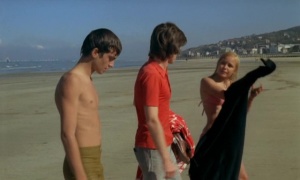
























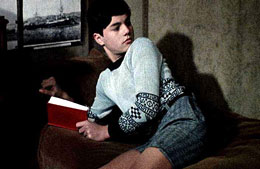
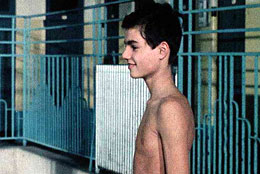








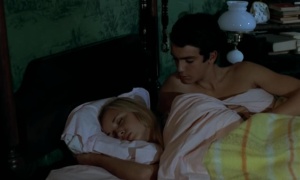











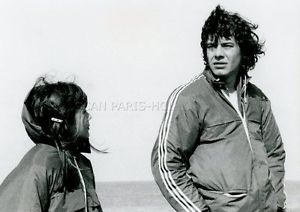







____
Further
Gérard Blain @ IMDb
RADICALEMENT BLAIN. RENCONTRE AVEC L’ACHARNÉ GÉRARD BLAIN
JUSQU’AU BOUT DE LA NUIT DE GÉRARD BLAIN
Gérard Blain coupe le monde en deux
Adidas and Dependencies: Gérard Blain As Director
gerard blain, une oeuvre exemplaire par son authenticité
Gerard Blain obit @ Variety
____
Extras
Gerard Blain in Francois Truffaut’s ‘Les Mistons’
Spécial Cannes : Gérard BLAIN
Gérard Blain (1999) by Gérard Courant
_____
Interview
from MUBI

NOTEBOOK: When did you first encounter the work of Gérard Blain?
BRAD DEANE: It’s funny. I knew him as an actor from the Olivier Assayas films as well as [Chabrol’s] Les cousins [1959] and Le beau serge [1958]. I didn’t really know he made films. Then seven years ago, me and Mia Hansen-Løve were talking. She was like, “Do you know the films of Gérard Blain?” I’m like, “No, not really. I don’t know his films, really. I know him as an actor, but I didn’t know he made films.” She was, “Oh, he’s the most amazing filmmaker,” and she went on and on, and was like, “Oh, you have to see his films. He’s this amazing filmmaker.”
I said, “Great. Hopefully, I can see these,” but, of course, none of them are on DVD. It’s impossible to see his work. Then I did a retrospective of Mia’s work with the TIFF Cinematheque and for her carte blanche selection, she chose A Child in the Crowd. So I got see that one, and I was of course blown away by it.
Then we talked about the idea of a retrospective, but it just seemed kind of complicated. I’d done research, trying to find elements from prints, and things like that, but it just seemed like a longer-term thing. Then last summer Olivier Assayas came, and for one of his carte blanche selections he chose Le pélican, and through that, I got in touch with Paul Blain, who’s in Mia’s first film, Tout est pardonné.
I got in touch to clear the [rights for the] film and I just started asking him a bit more in an e-mail: “How many of the films do you have?” He said, “Yeah, I have all of the films. I have 35mm prints of all of them. The problem is, most of them never have been subtitled before. They haven’t been translated.” I thought, “Okay, well, I need to figure out a way of doing this series.”
Luckily, I was talking with Samuel La France, who worked with me, and fortunately he speaks French, and he said, “You know, I’ve only seen Le pélican, but I love that film. I would love to see the rest of his films. For that alone, I’ll help translate some of the films.” Paul had some subtitles for some of them, but Sam helped. He translated the remaining films, so a handful of them will be translated for the first time with English subtitles. We’ve created subtitles, and hopefully now we can bring these amazing films to audiences.
I think that’s one of the main reasons why they’ve been out of circulation in North America, at least, was the subtitles. But I think there’s many other reasons, too, why his films are probably not known.
NOTEBOOK: The 1970s, when Blain was most active as a director, was certainly a very tumultuous period for French cinema. The government really cut off funding for films because they were kind of ashamed of the culture they represented, post-May ’68. This was also a period when Cahiers du cinéma was barely even writing about cinema, but rather about politics. I wonder if that’s a reason for maybe, his work falling through the cracks.
DEANE: I don’t know if it was that was so much. I think Gérard’s personality maybe played into it somewhat. He’s such an uncompromising figure as an actor. He didn’t like compromise as a director, and he just really liked pushing the boundaries and pushing people’s buttons.
He is a real rebel, and his films are about that. From everyone I’ve talked to who knew him, he liked to cause trouble. He really was dissatisfied with a lot of aspects of society, and he had his own kind of morality in a way. I think he probably upset a lot of people at the time and was not the easiest person, necessarily, to work with.
I think he also falls into a strange generation; the post-New Wave. I think we see that with [Jean] Eustache, [Maurice] Pialat, and Blain. I think the three of them work very interestingly together. Actually, the Austrian Film Museum did a series with the three filmmakers, focusing on all three, and I think there’s this interesting link, in a way, between the French New Wave, and the following generations. But it’s funny, because those three filmmakers are probably the least well-known. Pialat finally has received the attention he deserves, but they were all these very kind of uncompromising, difficult characters.
The interesting thing about Blain though, is that he actually is a product of the French New Wave in a weird way. That’s how he got his start. He became famous as an actor in the French New Wave films. He knew Godard, Truffaut and he worked with all of these people.
But he did make films very differently. He didn’t make New Wave films, and if anything, the films he makes are probably closer to Bresson, who always kind of had his own way of making films too.
I think those were some major factors in why he’s not as well known, because we’ve seen the same with Pialat. Pialat’s a genius, as well, and only recently Pialat has been discovered. And Eustache didn’t make that many films, either. Of course, he made two masterpiece feature films, and a bunch of shorts, but, yeah—you wonder why these filmmakers didn’t make more.
NOTEBOOK: I think with Pialat and if you want to count Luc Moullet, the comparison’s interesting, too, because all three of these people, they intermittently put themselves in their own films, as well. You’d think that it would almost make them more recognizable, the fact that they’re presences within their own films.
DEANE: Yeah, and he was friends with Pialat, too. He knew Pialat quite well, Paul told me.
NOTEBOOK: How much is really known about his life?
DEANE: With Gérard, not a lot. I just recently interviewed his son in Paris, and got to learn a lot more, and also from talking to Olivier Assayas, who was also friends with him. I’ve gotten to learn a lot more about his life, recently. When you do a series like this and you’re trying to research it, it’s like, well, what do you find? There’s barely anything on him in English, and then, even in French, there’s not a whole lot written about him. There have been retrospectives in France, in Paris. I know, talking to Olivier, that’s how he discovered him.
Olivier cast him in his own film, Winter’s Child [1989] which was, as Olivier describes, a homage to Gérard’s films, because he was such a huge fan and he told me he went and presented the films when they would show in Paris. But even he was kind of baffled as to why he’s not better known, because they have shown in France, at least, and even in France, they’re not as well-known as they should be. But North America, it’s nonexistent, really, until now. We’re going to change that though.
NOTEBOOK: One of the quotes going around for this retrospective is that “he’s the real inheritor to Bresson.” It’s interesting, because I think Bresson really haunts this whole building and organization, what with the giant posters for his films hung up here and how he always pops up almost every season in the Cinematheque Special Screenings. Is this retrospective partly a realization of that?
DEANE: We have a long history at the Cinematheque with Bresson. James Quandt has put together these large Bresson retrospectives many times over the years, back when people weren’t doing this, and he’s done two books on Bresson. So, James has built this really great audience in Toronto for Bresson, and it’s funny, because we even get this from distributors in the US sometimes, when we want to show the films and they’re like, “Wow, you guys draw so much better for Bresson than almost anywhere else.”
I think we’ve built an audience, but I think Bresson’s reputation has increased over the years, too. I think it’s become much more widely recognized for what a genius and what a great filmmaker he is, and how genuinely unique he is in the history of cinema.
Gérard was friends with Bresson and I think his films very much follow in that Bressonian way of filmmaking. I don’t think they’re copies in any way. I don’t think he’s imitating him. I don’t think that would be very interesting. But I think, when you read something like Notes on the Cinematograph by Bresson, I feel like Blain is very much in line with that, philosophically, about the way he approached cinema, something that was about precision. It was very concise. The editing, the performances, were more subdued, which is all extremely cinematic, too.
________________
8 of Gérard Blain’s 9 films
_____________
Les amis (1971)
‘The first film directed by the actor Gérard Blain has a touchy subject : an old-fashioned pederastic relation between a mature married man and minor of 16 (in France, then, the majority was of 21). It is filmed in very sober, minimalist style (Blain was a Bresson admirer), there is nothing shocking in sight, but plenty of delicate situations. And the boy is also in love with a blonde society girl. It seems that it is a near auto-biographical film : Blain had a tough childhood and found help and affection with older men. Later he married and had children, but directed this film and then others on this subject without shame or anything negative. And “Les amis” went to Cannes festival, got a prize at Locarno … So the past could be more tolerant than our present. It is an old-fashioned film with a daring content, which surprises because most of the time we see the opposite. As I thought, it is a bit disturbing : we know such things exist, but we never see them, usually. It is bold and courageous. Blain was not an easy character in life, and not a lot of people would dare to direct such a film, a film which never blinks, never give place to conventions and common moral, but is in its way, because of all this, gives a moral lesson : never judge, consider only facts and how people are inside. The last scene is the key and the morality of the whole film. Finally, it was worthy to watch it.’ — chrismass61
the entire film
_______________
Le pélican (1974)
‘Blain’s achingly moving portrait of paternal love focuses on jazz musician and new father Paul (Blain), who, seeking to satisfy his wife’s upwardly mobile desires, takes part in an illegal scheme that promptly lands him in prison. Released many years later, Paul discovers that his wife has remarried to a wealthy man. Tracing them to their luxurious summer house in Switzerland, Paul spies on the new family, hoping to one day reunite with his young son. “Using a minimum of means with a maximum of precision, [Blain’s] portrait of Paul’s obsessive desperation in the face of inevitability emerges with shattering clarity.’ — Christoph Huber
Opening credits
________________
Un enfant dans la foule (1976)
‘Considered one of the great lost masterpieces of 1970s French cinema, Un enfant dans la foule takes place in Nazi-occupied France, where young Paul (César Chaveau) is forced to fend for himself after being abandoned by his parents. Struggling to survive and yearning for affection and acceptance, Paul is picked up by men on the street and performs small jobs for German soldiers, his emotional rootlessness leading him from collaboration into the Resistance. Partially based on the director’s own wartime childhood, Blain’s cruel story of youth employs Bressonian restraint in its vision of a world whose unremitting harshness places the film’s fleeting moments of compassion and connection in powerful relief; watch for Blain’s moving cameo in the final shot, a fusion of art and life that seems to promise a transcendence of trauma through the medium of film.’ — TIFF
the entire film
________________
Un second souffle (1978)
‘Fiftysomething dental surgeon François (Robert Stack) leaves his loving wife and three children in order to enjoy a life free of responsibility, beginning a relationship with a much younger woman, Catherine (Anicée Alvina), who confesses that she is also having an affair with Marc (Frédéric Meisner), a motorcycle-riding man her own age. Undeterred, François befriends Marc and gets his own motorcycle, but when he suffers an accident, he is forced to confront the limitations of his aging body and the reality of his waning youth, harsh realities counterposed to undying hope in this frank, human film.’ — Metrograph
Excerpt
Excerpt
_______________
Le rebelle (1980)
‘After the death of his parents, Pierre (Patrick Norbert) is forced to care for his younger sister Nathalie by committing petty crimes. In a recurring motif of Blain’s cinema, Pierre is taken under the wing of an older gay man, Hubert (Michel Subor), who offers him work and financial security; but when Hubert makes advances to him, Pierre robs him and takes up with a group of radical leftists who are planning terrorist attacks. Without employment, Pierre loses Nathalie to child services and spirals into desperation, finally erupting in an act of horrific violence. “This sinister portrait of rebelliousness in times of economic and social hardship may betray some of Blain’s frustration — but it reveals even more about the true inner life of his era.’ — Christoph Huber
Excerpt
_______________
Pierre et Djemila (1987)
‘Set in a housing project in the northern French town of Roubaix, Blain’s Romeo and Juliet redux chronicles the star-crossed love affair between sensitive French teen Pierre (Jean-Pierre André) and Djemila (Nadja Reski), the daughter of Algerian immigrants. Separated by both cultural barriers and racially charged bitterness — Pierre’s father is an Algerian War veteran, while Djemila’s older brother despises the French for their brutal repression in his homeland — the young lovers see each other in secret, until the intervention of a family member leads to tragedy. Co-written by Mohamed Bouchibi, a former member of the Algerian National Liberation Front (FLN), Pierre et Djemila became a lightning rod for controversy when it premiered at the 1987 Festival de Cannes, where Blain’s recognition of cultural divides within French society (“I am not making films to find solutions,” he said in an interview) led some commentators to accuse the film of being anti-immigrant and serving the cause of the right-wing Front National.’ — TIFF

________________
Jusqu’au bout de la nuit (1995)
‘Following an eight-year hiatus as a director, Blain returned with this subversive thriller that, like Maurice Pialat’s Police, uses the genre format to create something much more: “not a gangster film, but a love story and a relentless tragedy,” as Blain described it. The director stars as François, a career criminal who is released after serving a 12-year prison sentence. He begins a relationship with a younger woman, Maria (Anicée Alvina), but his need for cash — and his uncompromising opposition to a “normal” society he detests — leads him back to his outlaw ways, and towards an explosive denouement. Employing Bressonian ellipses to enhance the emotional impact of its “action” scenes, Jusqu’au bout de la nuit is “halfway between an ultra-brooding polar [crime film] and Scarface [as] filmed by Jean-Marie Straub.’ — Olivier Père
Excerpt
_______________
Ainsi soit-il (1999)
‘Doggedly uncommercial, and paying not a whit of heed to changing fashion, former thesp Gerard Blain climbs behind the camera again for his eighth feature, “Ainsi soit-il,” another austere, Bressonian exercise shot through with implacable logic. Though Blain sets himself up for a fall each time with his undisguised admiration for the Gallic maestro of minimalism, he generally succeeds in bringing it off — not least here, in a drama about a son solving the mystery of his father’s death that has a genuine power and spirituality for those attuned to reductive cinema. All the Bressonian hallmarks are there: fixed camera, simple but precise cutting, slightly stilted, formal dialogue, and dispassionate exteriors hiding grand emotions. As Regis, Paul Blain even possesses the same wounded-deer look of some of Bresson’s classic heroes (“Diary of a Country Priest,” “Pickpocket,” “A Man Escaped”), a moral martyr to a cause that’s higher than the law — represented here by a sympathetic but by-the-book cop — can ever understand.’ — Variety
Excerpt
*
p.s. Hey. ** Kyler, Hi, K. Ah, finally some good blog news! Quite a relief. Thanks for letting me know. ** Steve Erickson, Hi, Well, it’s frustrating in the sense I can’t do anything to solve the problems you’re having apart from re-giving my earlier browser-related advise, at least for now. Revisiting the Mekons could be an interesting thing to do. Hm. I hope your shot list turned out well and wasn’t too taxing to figure out. Everyone, Mr. Erickson himself has a couple of new film reviews up and devourable. Here’s him on Rob Tregenza’s GAVAGAI, and here’s him on Nelson Carlo de Los Santos Arias’ COCOTE. Oh, there’s the Blain post I managed to put together up there. obviously, if it’s of interest. ** Tosh Berman, Hi, Tosh! Thanks for propping Ben’s thing. ** Alex rose, Hi, Alex! Well, you making work is always great news. New solo show! Yes, your work should reach furthest and widest. Can Jimi help with trying to find galleries over here? I know some dealers do that. If I can think of a Paris gallery or great locale that I (or local comrades) have any connections to, I’ll do my part. Never enough about you. The severe heat is back, motherfucking sun! Love (save), me. ** _Black_Acrylic, Thank you again in huge bucketfuls, Ben! ** Sypha, Another blog viewing success story! Hooray! It sounds like Chrome might be some kind of mini-saviour? Thanks! ** Statictick, Hi, N. Gotcha on the Netflix-occasioned delve into stand-up. Yeah, it just doesn’t speak to me. Well, mostly. I saw Phyllis Diller do a stand-up thing late in her life, and that was total genius. Bloomberg Business? Maybe that’s enough info for a google search and recovery mission. Love back. ** Misanthrope, I was thinking ‘pitch’ as in pitch black. Whatever the hell that means other than really, really black. Yeah, madness, those stories. I’m so happy for that reason among a million reasons that I’m over where people are encouraged to think for a while before they pronounce. Great about the private browser success! Some kind of hampered victory there. ** Okay. Steve Erickson and I were talking about the French filmmaker/actor Gerard Blain recently, and that lead me to building this post to cover his work, which I suspect most of you are unfamiliar with. I hope you’ll investigate him and wind up with more things inside that you can then use at your leisure. See you tomorrow.




 Now available in North America
Now available in North America 
Merci pour le Blain!
Ah Dennis, I guess I spoke too soon, as today it’s once again showing zero comments. Ah well, it was nice to have it back for one day, at least.
A quick request. That Neo-Decadent Day I did back in April, for DROWNING IN BEAUTY. One of the contributors, Urusla Pflug, wants to have the segment she wrote for her contribution appear on some other site, but apparently they frown on using material that has previously appeared elsewhere, so she was wondering if you could kindly get rid of her contribution. I hope that’s not too much of a hassle.
Hi!!
First, the now-usual question: how are things going with ARTE?
I’m really happy to hear – though I’m a tad bit late to reply, I mean it was a week ago – that you met Scott Barley and he’s as amazing as his films seem to be! Right now, I’m really in the mood to watch something but it’s also the mood when I just can’t put my finger on what I feel like watching, exactly. Do you ever have this?
It’s crazy, but our heatwave is STILL unbroken! We get a few quick storms here and there but the temperature stays extremely high even during and after them… How are things on your end?
My brother’s living with us, yes, and it’s so great to have him around! I ended up spending the whole week home because of my stomach bug but it’s not too serious so it was shameless vacationing mostly. I did finish the White Eagle book, though. Now I’m waiting for their feedback – I really hope they’ll be satisfied and won’t ask me to work on it further, haha.
How are you? How was your week? Have an awesome weekend, Dennis!
Re yesterday’s Drunken Bakers Day:
@ Sypha, agreed there’s a depressive streak to be found in much British humour but I see it as being an insight into the human condition. It’s innate within seaside postcards, Carry On films and all that sort of stuff.
@ Statictick, thank you! Barney Farmer’s book is very highly recommended.
@ Misa, funny as hell and depressing are definitely two sides of the same coin.
I was over at the Generator earlier this evening for their new exhibition – 2 separate shows by the husband and wife team of Simon Carman and Helen Sharp, a couple who live over in Northern Ireland and have each had their practices going for a good few years. No kidding, this was the most impressive thing I’ve seen in any gallery space for a very long time. I did take a few photos: in the first room Mr Carman is a highly regarded stone sculptor and he showed 2 pieces, The Black Cow Of Inisherk and Grace Jones, both technical marvels. Meanwhile next door in the second space, the strains of Suicide – Dream Baby Dream were echoing on a loop, the soundtrack to Helen Sharp’s installation After Airpolina in a kind of bucolic fantasia that I found really affecting. So wow, it must seem like I’m raving but this really was the kind of art experience that brings me a whole lot of joy.
Late last night, I could read 5 comments on yesterday’s post, but from the number of replies you made, I know there must have been more. I can’t see any now.
Did you know that a Doctors of Madness box set (with different unreleased bonus tracks than the ones on previous CD editions of their albums) came out in the UK last year?
I’d be interested in doing a Day here on the “response video” at some point, but I’d want to be sure I could actually read all the replies first. Like the AMSR video and “unboxing video” (as I told Misanthrope a few days ago, I watched an odd “unboxing video” where a guy ordered a “mystery box” from the Silk Road using TOR and Bitcoin and freaked out at the results, which were nowhere near as dangerous as they could’ve been), it’s a form that seems specific to YouTube. There’s a 9-year-old boy who films himself listening to hip-hop and R&B with his 50-something dad (who became a fan of Brockhampton and Kali Uchis as a result, but kept complaining about the explicit language Run the Jewels used; they also did the concept in reverse, where dad played the kid the Stooges, Sex Pistols, Clash and Gang of Four and tried to explain the virtues of punk.) Weirdly, the 9-year-old is way more articulate about the music he likes than almost every older teen or young adult who does the same concept, and most of these tend to generally get diverted into the few same areas: earnest political discussions based on song lyrics, shock at how druggy, sexually explicit, etc. they are, or generation-gap “’90s hip-hop was so much better than SoundCloud rap/no dad, it’s not” arguments. If there were more provocative popular rock bands, I’m sure they wouldn’t all be about hip-hop, but while I’m sure there are teenage feminists who love Soccer Mommy, Camp Cope & U.S. Girls and have conservative parents who’d argue about their lyrics, if these videos exist, they’re buried on YT.